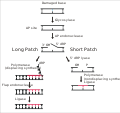Molecular lesion
Molecular Lesion refers to a specific, localized change or damage to the molecular structure of DNA, RNA, or protein molecules within cells. These lesions can result from various internal and external factors, including oxidative stress, radiation, chemical exposure, and errors during DNA replication or repair. Understanding molecular lesions is crucial in the fields of molecular biology, genetics, and medicine, as they are often the initiating events leading to mutations, cancer, and other genetic disorders.
Types of Molecular Lesions
Molecular lesions can be broadly categorized based on the molecule affected (DNA, RNA, or protein) and the nature of the damage.
DNA Lesions
DNA lesions are perhaps the most studied due to their critical role in genetic inheritance, cell cycle regulation, and cancer development. Common types of DNA lesions include:
- DNA double-strand breaks (DSBs)
- Single-strand breaks (SSBs)
- Base modifications (e.g., oxidation, methylation)
- Crosslinks (both interstrand and intrastrand)
RNA Lesions
While RNA lesions are less well-understood, they can significantly affect gene expression and protein synthesis. Types of RNA damage include:
- mRNA degradation
- tRNA and rRNA modifications
- RNA editing errors
Protein Lesions
Protein lesions often result from misfolding, aggregation, or chemical modifications, leading to loss of function or toxic gain of function. Examples include:
- Amyloid fibrils in neurodegenerative diseases
- Oxidized proteins due to reactive oxygen species
- Ubiquitination and proteasomal degradation failures
Causes of Molecular Lesions
Molecular lesions can arise from endogenous sources, such as metabolic processes and cellular respiration, or from exogenous sources, including:
- Ultraviolet (UV) radiation
- Ionizing radiation
- Chemical carcinogens
- Viral infections
Detection and Repair
Cells have evolved complex mechanisms to detect and repair molecular lesions, maintaining genomic stability and preventing disease. Key repair pathways include:
- Nucleotide excision repair (NER) for UV-induced lesions and bulky chemical adducts
- Base excision repair (BER) for small base modifications
- Mismatch repair (MMR) for replication errors
- Homologous recombination (HR) and Non-homologous end joining (NHEJ) for DSBs
Clinical Significance
Molecular lesions play a pivotal role in the development of many diseases, particularly cancer. Understanding the mechanisms of lesion formation and repair provides insights into cancer prevention, diagnosis, and treatment. Additionally, molecular lesions are targets for certain chemotherapeutic agents and radiation therapy, which aim to induce lethal damage in cancer cells.
Molecular_lesion
Transform your life with W8MD's budget GLP-1 injections from $125.
W8MD offers a medical weight loss program to lose weight in Philadelphia. Our physician-supervised medical weight loss provides:
- Most insurances accepted or discounted self-pay rates. We will obtain insurance prior authorizations if needed.
- Generic GLP1 weight loss injections from $125 for the starting dose.
- Also offer prescription weight loss medications including Phentermine, Qsymia, Diethylpropion, Contrave etc.
NYC weight loss doctor appointments
Start your NYC weight loss journey today at our NYC medical weight loss and Philadelphia medical weight loss clinics.
- Call 718-946-5500 to lose weight in NYC or for medical weight loss in Philadelphia 215-676-2334.
- Tags:NYC medical weight loss, Philadelphia lose weight Zepbound NYC, Budget GLP1 weight loss injections, Wegovy Philadelphia, Wegovy NYC, Philadelphia medical weight loss, Brookly weight loss and Wegovy NYC
|
WikiMD's Wellness Encyclopedia |
| Let Food Be Thy Medicine Medicine Thy Food - Hippocrates |
Medical Disclaimer: WikiMD is not a substitute for professional medical advice. The information on WikiMD is provided as an information resource only, may be incorrect, outdated or misleading, and is not to be used or relied on for any diagnostic or treatment purposes. Please consult your health care provider before making any healthcare decisions or for guidance about a specific medical condition. WikiMD expressly disclaims responsibility, and shall have no liability, for any damages, loss, injury, or liability whatsoever suffered as a result of your reliance on the information contained in this site. By visiting this site you agree to the foregoing terms and conditions, which may from time to time be changed or supplemented by WikiMD. If you do not agree to the foregoing terms and conditions, you should not enter or use this site. See full disclaimer.
Credits:Most images are courtesy of Wikimedia commons, and templates, categories Wikipedia, licensed under CC BY SA or similar.
Contributors: Prab R. Tumpati, MD




